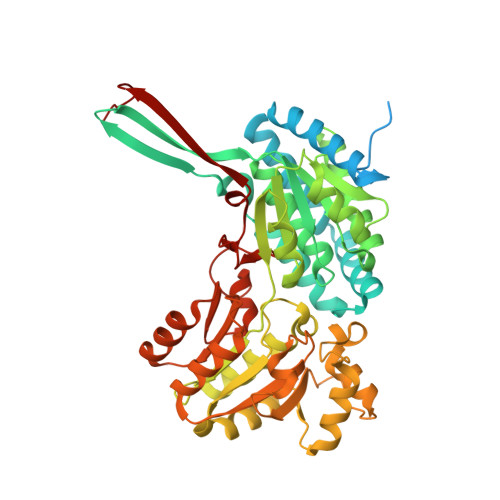Design and in vitro realization of carbon-conserving photorespiration.
Trudeau, D.L., Edlich-Muth, C., Zarzycki, J., Scheffen, M., Goldsmith, M., Khersonsky, O., Avizemer, Z., Fleishman, S.J., Cotton, C.A.R., Erb, T.J., Tawfik, D.S., Bar-Even, A.(2018) Proc Natl Acad Sci U S A 115: E11455-E11464
- PubMed: 30459276
- DOI: https://doi.org/10.1073/pnas.1812605115
- Primary Citation of Related Structures:
6GVS - PubMed Abstract:
Photorespiration recycles ribulose-1,5-bisphosphate carboxylase/oxygenase (Rubisco) oxygenation product, 2-phosphoglycolate, back into the Calvin Cycle. Natural photorespiration, however, limits agricultural productivity by dissipating energy and releasing CO 2 Several photorespiration bypasses have been previously suggested but were limited to existing enzymes and pathways that release CO 2 Here, we harness the power of enzyme and metabolic engineering to establish synthetic routes that bypass photorespiration without CO 2 release. By defining specific reaction rules, we systematically identified promising routes that assimilate 2-phosphoglycolate into the Calvin Cycle without carbon loss. We further developed a kinetic-stoichiometric model that indicates that the identified synthetic shunts could potentially enhance carbon fixation rate across the physiological range of irradiation and CO 2 , even if most of their enzymes operate at a tenth of Rubisco's maximal carboxylation activity. Glycolate reduction to glycolaldehyde is essential for several of the synthetic shunts but is not known to occur naturally. We, therefore, used computational design and directed evolution to establish this activity in two sequential reactions. An acetyl-CoA synthetase was engineered for higher stability and glycolyl-CoA synthesis. A propionyl-CoA reductase was engineered for higher selectivity for glycolyl-CoA and for use of NADPH over NAD + , thereby favoring reduction over oxidation. The engineered glycolate reduction module was then combined with downstream condensation and assimilation of glycolaldehyde to ribulose 1,5-bisphosphate, thus providing proof of principle for a carbon-conserving photorespiration pathway.
- Department of Biomolecular Sciences, Weizmann Institute of Science, 7610001 Rehovot, Israel.
Organizational Affiliation:


















